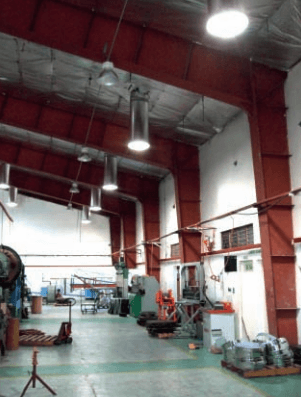Facility: Manufacturing Plant.
Location: Pampanga, Philippines.
Orientation: Building faces NNW, meaning Sky Tunnels will be installed on roofs facing WSW & ENE.
Application: General Factory Lighting
Product: 535mm Sky Tunnel with upto 1500mm
98% Reflective Miro Silver Tubing.
Quantity: 56 of - evenly distributed.
Objective: Install Natural Lighting to improve overall light levels. This will assist the quality control procedures to be carried out more effectively, improve staff comfort and reduce the expenditure on energy such as electricity.
Energy: Prior to the Installation of the 56 x Sky Tunnels, the manufacturing plant was utilising 40 x 400W Hi-bay lights for up to 50 hours per week. This equates to approx 41,600kWh in a 12 month period.
Solar Heat Gain
Testing of the temperatures on site prior to Sky Tunnel Installation, the following results were observed:
Outside in shade: 32.3º C Underside of Roof Sheet: 45.5º C
Inside at working height: 26.3º C Underside of Insulation: 29.1º C
Bottom of 400W Globes: 94.5º C
Testing of the temperatures on site after Sky Tunnel Installation, the following results were observed:
Outside in shade: 32.0º C Underside of Roof Sheet: 45.3º C
Inside at working height: 25.8º C Underside of Insulation: 29.0º C
Bottom of Sky Tunnel Diffusers: 29.8º C
As can be seen from the above results, the 56 x Sky Tunnels produce less impact on the overall heat load on the building
than the 40 x 400W Hi-bay lights that were being utilised.
SG Eco Welcomes interested parties (by appointment) to visit this factory to experience these amazing results
for themselves.
Light Levels
 Tests were conducted in the month of December, when the sun is at its lowest angle for the year in the Philippines. The days are also at their shortest, with only just over 11 hours of sunlight. This decreases the available light, which affects the performance of the Sky Tunnels. Levels increase throughout the year, peaking in June. In the Southern Hemisphere, the results would be the opposite.
Tests were conducted in the month of December, when the sun is at its lowest angle for the year in the Philippines. The days are also at their shortest, with only just over 11 hours of sunlight. This decreases the available light, which affects the performance of the Sky Tunnels. Levels increase throughout the year, peaking in June. In the Southern Hemisphere, the results would be the opposite. Light Levels were tested prior to Installation of the Sky Tunnels, with all other light sources such as rollers doors & windows closed. The Light Levels were then tested after installation, with other light sources blocked again. The light levels were tested at three different times of the day to show the duration of their effective performance without the need for the 40 x 400W Hi-bay lights.
Positions were randomly chosen throughout the plant, therefore distance from roof to ceiling (6.5m to 8.6m), as well as positioning of pallet racking and machinery also affects the overall performance in any given position. Light levels were measured at a working height of 700mm above the floor.
The results show that the Sky Tunnels give a performance equal to or greater than the existing electric lighting for a minimum of 5 hours per day during the month of December. The factory is actually only running the electric lights for an hour in the early morning, and during summer months will not use the electric lights at all. Of greater note, the Sky Tunnels are generating more light than required for a particular task being undertaken in the area.
Conclusion
The solar heat gain and light level results show that the 56 x Sky Tunnels installed have exceeded the initial objectives of the project.
* Staff comfort levels have been improved.
* Light levels have been improved for a significant
proportion of the working day.
* Energy usage has been reduced.
How much Energy has been saved?
Based on a 6 day working week = 50 Hours
Yearly energy use prior to installation:
40 x 400W Hi-Bay x 50 Hours = 41,600kWh
Yearly energy after Installation:
Sky Tunnels for 50 Hours = 0kWH
40 x 400W Hi-Bay x 12 Hours X 12 weeks = 2,304kWh *
* The Hi-Bay usage is based on November to January having less
available daylight in the early hours of the morning in the Philippines.
This represents a saving of approx 39,000kWh per year!
The savings in electricity expenditure could pay for the product & installation in under 2 years.
This is dependant on several factors such as local Sky Tunnel product costs, installation costs, the hours of effective daylight being harnessed and the hours of operation. These need to be compared against the cost of alternative lighting
products, maintenance of these systems and the actual running costs.







